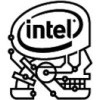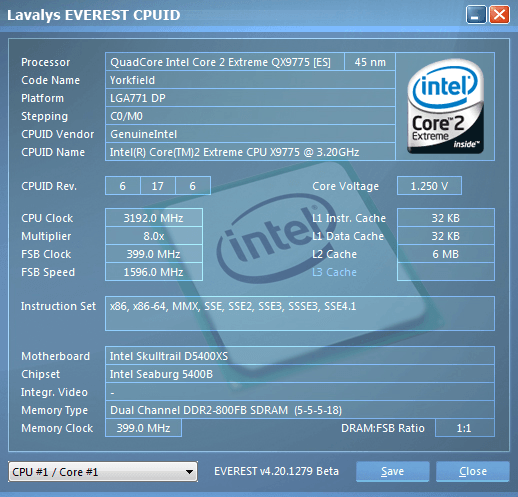- Qualcomm Launches Snapdragon 4 Gen 2 Mobile Platform
- AMD Launches Ryzen PRO 7000 Series Mobile & Desktop Platform
- Intel Launches Sleek Single-Slot Arc Pro A60 Workstation Graphics Card
- NVIDIA Announces Latest Ada Lovelace Additions: GeForce RTX 4060 Ti & RTX 4060
- Maxon Redshift With AMD Radeon GPU Rendering Support Now Available
Intel Skulltrail Enthusiast Platform Preview

Consisting of two Extreme Quad-Core processors, Intel is looking to redefine what we know as “high-end”. Skulltrail is touted as being the “ultimate” enthusiast platform, offering SLI and Crossfire support, huge overclocking abilities and enough sheer power to make the competition weep.
Page 15 – Overclocking and Power, Final Thoughts
In taking a look at Skulltrail, we essentially reviewed three different products – the D5400XS motherboard, the QX9775 processor and the platform as a whole. Let’s begin with the first of the three.
Being a workstation-targeted motherboard, I was unsure of what to expect, but in the end I am quite pleased. Although I didn’t get to delve into overclocking personally, the board remained rock-solid-stable throughout all of the testing without as much as a single boot gone awry.
Feature-wise, the board doesn’t offer much more than it needs to. The on-board audio will suffice, and since it has Dolby’s blessing, you can be sure that it’s not going to disappoint overall. For higher-end audio though, Intel left two PCI slots readily available. You will just need to make your GPU purchases carefully, given the somewhat odd locations of the two.
The fact that the board includes an NVIDIA chipset with support for SLI is a huge draw in itself. NVIDIA’s own chipsets haven’t proven to be a spectacular choice, while Intel have been delivering superb offerings for a few years now, especially since P35’s launch last May. The 5400 chipset used here proved to offer great performance as well, with little latency when carrying data between the two processors.
The processors themselves are extremely fast, but there was no doubt of that before installing them. Considering that the Core 2 Extreme QX9770 offers identical speeds and similar specs gives away the fact that both would perform comparably, which they did. Although the Xeon X5482, out since November, delivers on near-identical specifications as the QX9775, the latter will be the first LGA771-based “desktop” enthusiast offering.

Overclocking-wise, the chips deliver as well. As explained earlier, I was unable to perform this testing due to a shipping issue with the required PSU, but from what I’ve seen personally, the skies the limit. On good air-cooling, 3.6GHz – 3.8GHz can be reached stable, although airflow should be amazing for that to be a 24/7 rig.
On water-cooling or anything higher, 4.0GHz and beyond is a definite reality. For the extreme overclocker with an incredible cooling setup, speeds as high as 5.0GHz can be reached. One friend of the site had his Skulltrail on sub-zero cooling and had it operating at 4.8GHz stable, so the speed potential is remarkable and goes to show just how efficient Intel’s 45nm architecture is.
I also didn’t touch on the power consumption too much, but overall it’s also quite impressive, and much better than you’d imagine. On the QX9770 machine, topping out the processor would result in a a PC that eats 312W on average. On the Skulltrail side, while topping out a single processor, the result was 320W… slightly higher.
However, when both processors were being fully utilized, the wattage only jumped up another 55W, to sit at 375W. That is not fantastic, but we are dealing with two high-end Quad-Cores here. With the 8800GTX also churning, the power cap jumped to 460W, still quite reasonable.
Final Thoughts
As mentioned in the intro, Skulltrail is designed for a few different crowds – the main being the ultimate multi-tasker. It’s true, equipped with such a rig is guaranteed to offer the absolute best multi-tasking experience on the market, there’s no arguing that. Having eight fast cores at your disposal allows a whack of flexibility and helps you get the job done fast in the process.
Though touted as a gaming platform as well, the fact that the system contains eight cores won’t mean much, unless you are a massive Flight Simulator X buff, as that’s the only game right now to actually take advantage of something larger than a Quad-Core.
However, even though games will not take advantage of all eight cores, Skulltrail opens up the ability to have processes running in the background while you get your geek on. Folding while playing the latest FPS game is one scenario, or burning a DVD while re-encoding a movie while gaming is another. There is a lot of breathing room, and that will be the main draw for most people. For the best overall multi-tasking though, 8GB of RAM (4x2GB) and a 64-Bit OS would be a smart choice.
Skulltrail also takes care of the workstation niche, allowing incredible render times with applications that take advantage of multi-threaded processes. In our tests, we rarely found an application to use more than six, but again, that leaves two open for regular computer use on the side. That’s not to say that such applications can’t use all eight cores, because they definitely can. We were unable to make it happen with our specific workloads, however.
The fact of the matter is: Skulltrail is the ultimate high-end enthusiasts platform. For those who want a machine with power bursting out the seams, Skulltrail is the true solution. It offers a total of eight cores, allows for extreme overclocking, supports NVIDIA SLI and AMD CrossFire and can handle up to 8GB of RAM. It’s an absolute beast, and one that many people are going to have a difficult time in trying to fully exploit.
Intel is not releasing pricing information at current time, but the QX9775 processors will cost more than the QX9650, which currently sell for $999 in quantities of 1,000. The D5400XS’s price is also being kept under wraps, but is expected to hover around the $499 mark.
As for a launch time frame, “within 30 days” is what we are told. Skulltrail as a platform will be launched two ways, via high-end PC boutiques (no names have been officially mentioned yet) and also via the retail channel. At launch, you will be able to pick up the board, FB-DIMM modules and two LGA771 processors and build your very own Skulltrail system. Tempting, isn’t it?
If you have a comment you wish to make on this review, feel free to head on into our forums! There is no need to register in order to reply to such threads.
Support our efforts! With ad revenue at an all-time low for written websites, we're relying more than ever on reader support to help us continue putting so much effort into this type of content. You can support us by becoming a Patron, or by using our Amazon shopping affiliate links listed through our articles. Thanks for your support!





